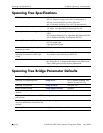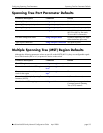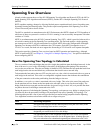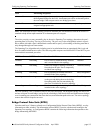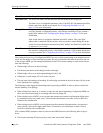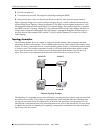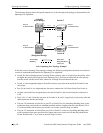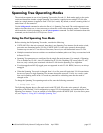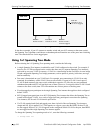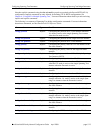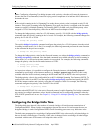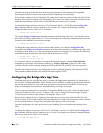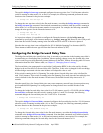
Spanning Tree Operating Modes Configuring Spanning Tree Parameters
page 5-10 OmniSwitch 6600 Family Network Configuration Guide April 2006
Flat Spanning Tree Example
In the above example, if port 8/3 connects to another switch and port 10/5 connects to that same switch,
the Spanning Tree Algorithm would detect a redundant path and transition one of the ports into a blocking
state. The same holds true for the tagged ports.
Using 1x1 Spanning Tree Mode
Before selecting the 1x1 Spanning Tree operating mode, consider the following:
• A single Spanning Tree instance is enabled for each VLAN configured on the switch. For example, if
there are five VLANs configured on the switch, then there are five separate Spanning Tree instances,
each with its own root VLAN. In essence, a VLAN is a virtual bridge in that it will have its own bridge
ID and configurable Spanning Tree bridge parameters, such as protocol, priority, hello time, max age,
and forward delay.
• Port state is determined on a per VLAN basis. For example, port connections in VLAN 10 are only
examined for redundancy within VLAN 10 across all switches. If a port in VLAN 10 and a port in
VLAN 20 both connect to the same switch within their respective VLANs, they are not considered
redundant data paths and STP will not block one of them. However, if two ports within VLAN 10 both
connect to the same switch, then STP will transition one of these ports to a blocking state.
• Fixed (untagged) ports participate in the single Spanning Tree instance that applies to their configured
default VLAN.
• 802.1Q tagged ports participate in an 802.1Q Spanning Tree instance that allows the Spanning Tree to
extend across tagged VLANs. As a result, a tagged port may participate in more than one Spanning
Tree instance; one for each VLAN that the port carries.
• If a VLAN contains both fixed and tagged ports, then a hybrid of the two Spanning Tree instances
(single and 802.1Q) is applied. If a VLAN appears as a tag on a port, then the BPDU for that VLAN
are also tagged. However, if a VLAN appears as the configured default VLAN for the port, then BPDU
are not tagged and the single Spanning Tree instance applies.
To change the Spanning Tree operating mode to 1x1, enter the following command:
-> bridge mode 1x1
Switch
Port 2/5
Default VLAN 5
VLAN 6 (tagged)
Port 1/2
Default VLAN 5
VLAN 10 (tagged)
Port 10/5
Default VLAN 20
Port 8/3
Default VLAN 2
Flat STP



